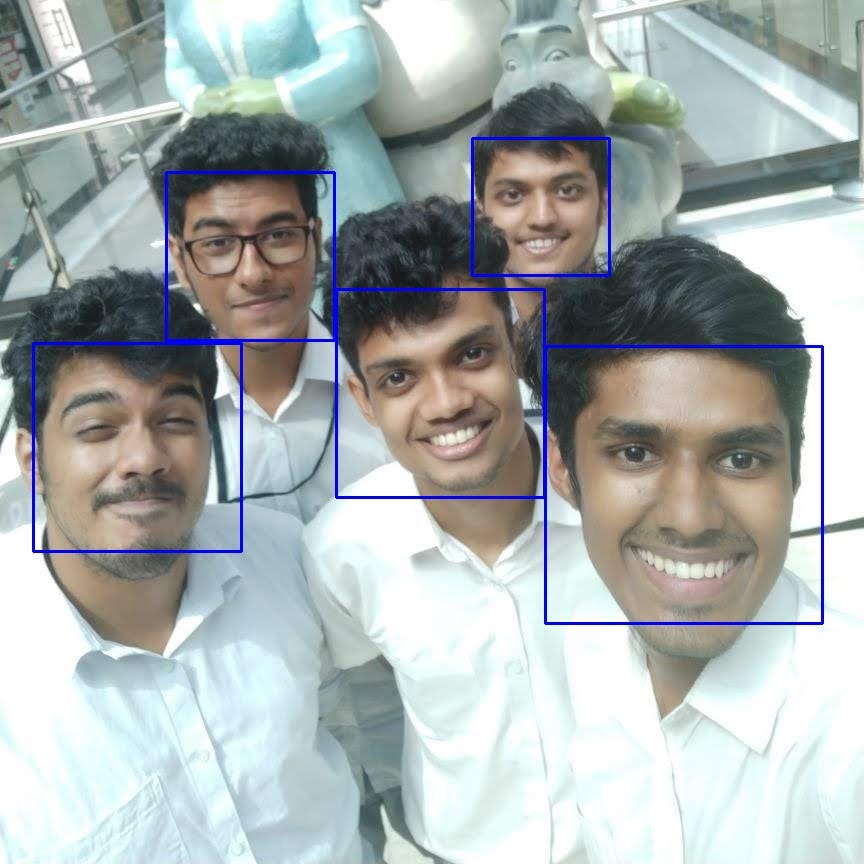First of all make sure you have OpenCV installed. You can install it using pip:
pip install opencv-pythonFace detection using Haar cascades is a machine learning based approach where a cascade function is trained with a set of input data. OpenCV already contains many pre-trained classifiers for face, eyes, smiles, etc.. Today we will be using the face classifier. You can experiment with other classifiers as well.
You need to download the trained classifier XML file (haarcascade_frontalface_default.xml), which is available in OpenCv’s GitHub repository. Save it to your working location.
To detect faces in images:
import cv2
# Load the cascade
face_cascade = cv2.CascadeClassifier('haarcascade_frontalface_default.xml')
# Read the input image
img = cv2.imread('test.jpg')
# Convert into grayscale
gray = cv2.cvtColor(img, cv2.COLOR_BGR2GRAY)
# Detect faces
faces = face_cascade.detectMultiScale(gray, 1.1, 4)
# Draw rectangle around the faces
for (x, y, w, h) in faces:
cv2.rectangle(img, (x, y), (x+w, y+h), (255, 0, 0), 2)
# Display the output
cv2.imshow('img', img)
cv2.waitKey()A few things to note:
- The detection works only on grayscale images. So it is important to convert the color image to grayscale. (line 8)
- detectMultiScale function (line 10) is used to detect the faces. It takes 3 arguments — the input image, scaleFactor and minNeighbours. scaleFactor specifies how much the image size is reduced with each scale. minNeighbours specifies how many neighbors each candidate rectangle should have to retain it. You can read about it in detail here. You may have to tweak these values to get the best results.
- faces contains a list of coordinates for the rectangular regions where faces were found. We use these coordinates to draw the rectangles in our image.
Results:

Similarly, we can detect faces in videos. As you know videos are basically made up of frames, which are still images. So we perform the face detection for each frame in a video. Here is the code:
import cv2
# Load the cascade
face_cascade = cv2.CascadeClassifier('haarcascade_frontalface_default.xml')
# To capture video from webcam.
cap = cv2.VideoCapture(0)
# To use a video file as input
# cap = cv2.VideoCapture('filename.mp4')
while True:
# Read the frame
_, img = cap.read()
# Convert to grayscale
gray = cv2.cvtColor(img, cv2.COLOR_BGR2GRAY)
# Detect the faces
faces = face_cascade.detectMultiScale(gray, 1.1, 4)
# Draw the rectangle around each face
for (x, y, w, h) in faces:
cv2.rectangle(img, (x, y), (x+w, y+h), (255, 0, 0), 2)
# Display
cv2.imshow('img', img)
# Stop if escape key is pressed
k = cv2.waitKey(30) & 0xff
if k==27:
break
# Release the VideoCapture object
cap.release()The only difference here is that we use an infinite loop to loop through each frame in the video. We use cap.read() to read each frame. The first value returned is a flag that indicates if the frame was read correctly or not. We don’t need it. The second value returned is the still frame on which we will be performing the detection.
Find the code here: https://github.com/adarsh1021/facedetection